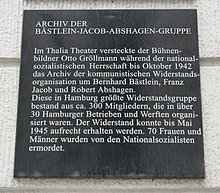Otto Gröllmann
Otto Gröllmann (born July 31, 1902 in Hamburg , † July 12, 2000 in Berlin ) was a German graphic artist , set designer and resistance fighter against the Nazi regime .
Life
Otto, known as 'Otje', Gröllmann trained as a theater painter from 1917 to 1920 at the Hamburger Schauspielhaus . He then worked at the Operettenhaus and at the Altona City Theater as a set designer. He came into contact with the Hamburg labor movement through Willi Bredel and the then USPD speaker Ernst Thälmann . In 1922 he became a member of the KPD . On October 23 and 24, 1923, he took part in the Hamburg uprising in Schiffbeck .
Gröllmann was the secretary of the Hamburg section of the “Association of Revolutionary Visual Artists” (ASSO) and the agitprop group of the workers' theater association “Die Nieter”, whose decorations and costumes he helped to design. He also drew many leaflets and banners as well as cover pictures for the “ Hamburger Volkszeitung ” (HVZ). He illustrated Willi Bredel's first book publication “Marat der Volksfreund”.
He was arrested in late 1933 because of his involvement in the resistance against the Nazi dictatorship. He was first sent to the Fuhlsbüttel concentration camp and in February 1934 to the Hamburg remand prison . Accused of his connection to the KPD, he was sentenced to 17 months in prison, which he spent in Wolfenbüttel prison. After imprisonment, he returned to the theater, but also worked as a painter in construction.
He soon found contact with his comrades Adolf Wriggers , Addi Matschke and Robert Abshagen , with whom he continued his resistance work. In 1938 he was employed as a studio manager and set designer at the Thalia Theater in Hamburg . The archive of the Bästlein-Jacob-Abshagen group was housed by Gröllmann in the Thalia Theater.
Gröllmann was arrested again in connection with the arrest of parachutists. After interrogation under torture by members of the SS , he and other prisoners were taken to the remand prison in March 1943. There he experienced the air raids on Hamburg in July 1943 and was "temporarily" released on August 4, 1943 as a result of the resulting chaos at the Hamburg judicial authorities. Gröllmann managed to evade re-arrest. He got back in touch with his resistance group, which continued to issue “illegal” leaflets until April 1945.
After the liberation from National Socialism , he resumed his work as a set designer at the Thalia Theater. In 1947 his daughter, the actress Jenny Gröllmann , was born.
On the initiative of Willi Bredel, he and his family moved to Schwerin in 1948 and to Dresden in 1954 , where he continued to work as a set designer at the local state theaters. During the fall of the Berlin Wall in 1989/90 "he repeatedly formulated harsh criticism of the Stalinist-seeming ancien régime Erich Honecker ".
In 1986 he was awarded the Gold Patriotic Order of Merit in the GDR .
literature
- Altes Museum (Berlin, Germany), Staatliche Museen zu Berlin (Germany: East), Christine Hoffmeister, Christian Suckow (Hrsg.): Revolution and Realism: Revolutionary Art in Germany 1917 to 1933, page 31, Staatliche Museen zu Berlin, 1978.
- Maike Bruhns: Art in Crisis. Volume 2: Künstlerlexikon Hamburg 1933–1945 , Hamburg 2001, ISBN 3-933374-95-2 , pp. 168–171.
- Florian Henckel von Donnersmarck: The life of others . Suhrkamp Verlag: Frankfurt am Main. - 2006, ISBN 3-518-45786-1 , p. 202.
- Kay Less : Between the stage and the barracks. Lexicon of persecuted theater, film and music artists from 1933 to 1945 . With a foreword by Paul Spiegel . Metropol, Berlin 2008, ISBN 978-3-938690-10-9 , p. 147.
Web links
- Holger Tilicki: An obituary for Otto Gröllmann ( Memento from March 12, 2005 in the Internet Archive )
Individual evidence
- ↑ Kay Less : Between the stage and the barracks. Lexicon of persecuted theater, film and music artists from 1933 to 1945 . With a foreword by Paul Spiegel . Metropol, Berlin 2008, ISBN 978-3-938690-10-9 , p. 148.
- ↑ Berliner Zeitung , April 30, 1986, p. 5
| personal data | |
|---|---|
| SURNAME | Gröllmann, Otto |
| ALTERNATIVE NAMES | Gröllmann, Otje |
| BRIEF DESCRIPTION | German set designer and resistance fighters against National Socialism |
| DATE OF BIRTH | July 31, 1902 |
| PLACE OF BIRTH | Hamburg |
| DATE OF DEATH | July 12, 2000 |
| Place of death | Berlin |
